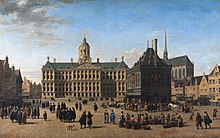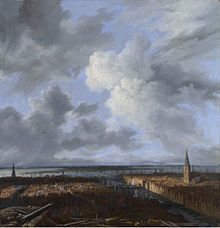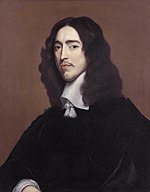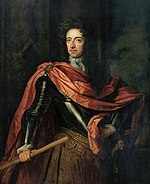
A | B | C | D | E | F | G | H | CH | I | J | K | L | M | N | O | P | Q | R | S | T | U | V | W | X | Y | Z | 0 | 1 | 2 | 3 | 4 | 5 | 6 | 7 | 8 | 9
Republic of the Seven United Netherlands Republiek der Zeven Verenigde Nederlanden (Dutch) | |||||||||
|---|---|---|---|---|---|---|---|---|---|
| 1579–1795 | |||||||||
| Motto: Eendracht maakt macht Concordia res parvæ crescunt "Unity makes strength" "Small things flourish by concord" | |||||||||
 Republic of the Seven United Netherlands in 1789 | |||||||||
| Capital | None (de jure) The Hague (de facto) | ||||||||
| Common languages | Dutch, Dutch Low Saxon, West Frisian | ||||||||
| Religion | Dutch Reformed (state religion),[1] Catholicism, Judaism, Lutheranism | ||||||||
| Demonym(s) | Dutch | ||||||||
| Government | Federal parliamentary republic | ||||||||
| Stadtholder | |||||||||
• 1581–1584 (assassinated) | William I | ||||||||
• 1584–1625 | Maurice, Prince of Orange | ||||||||
• 1625–1647 | Frederick Henry, Prince of Orange | ||||||||
• 1647–1650 | William II, Prince of Orange | ||||||||
• 1672–1702 | William III, Prince of Orange (from 1688, was also King William III of England) | ||||||||
• 1747–1751 | William IV, Prince of Orange | ||||||||
• 1751–1795 | William V, Prince of Orange | ||||||||
| Grand Pensionary | |||||||||
• 1581–1585 | Paulus Buys | ||||||||
• 1586–1619 | Johan van Oldenbarnevelt | ||||||||
• 1621–1629 | Anthonie Duyck | ||||||||
• 1631–1636 | Adriaan Pauw | ||||||||
• 1636–1651 | Jacob Cats | ||||||||
• 1651–1653 | Adriaan Pauw | ||||||||
• 1653–1672 | Johan de Witt | ||||||||
• 1672–1689 | Gaspar Fagel | ||||||||
• 1689–1720 | Anthonie Heinsius | ||||||||
• 1720–1727 | Isaac van Hoornbeek | ||||||||
• 1727–1736 | Simon van Slingelandt | ||||||||
• 1736–1746 | Anthonie van der Heim | ||||||||
• 1746–1749 | Jacob Gilles | ||||||||
• 1749–1772 | Pieter Steyn | ||||||||
• 1772–1787 | Pieter van Bleiswijk | ||||||||
| Legislature | States General | ||||||||
• State Council | Council of State | ||||||||
| Historical era | Early modern period | ||||||||
| 23 January 1579 | |||||||||
| 26 July 1581 | |||||||||
| 12 April 1588 | |||||||||
| 30 January 1648 | |||||||||
• Rampjaar | 1672 | ||||||||
| 11 April 1713 | |||||||||
| 19 January 1795 | |||||||||
| Population | |||||||||
• 1795 | 1,880,500[2] | ||||||||
| Currency | Guilder, rijksdaalder | ||||||||
| |||||||||
| Today part of | Netherlands Belgium | ||||||||
The United Provinces of the Netherlands, officially the Republic of the Seven United Netherlands (Dutch: Republiek der Zeven Verenigde Nederlanden), and commonly referred to in historiography as the Dutch Republic, was a confederation that existed from 1579 until the Batavian Revolution in 1795. It was a predecessor state of the present-day Netherlands, and the first independent Dutch state. The republic was established after seven Dutch provinces in the Spanish Netherlands revolted against Spanish rule, forming a mutual alliance against Spain in 1579 (the Union of Utrecht) and declaring their independence in 1581 (the Act of Abjuration). It comprised Groningen, Frisia, Overijssel, Guelders, Utrecht, Holland, and Zeeland.
Although the state was small and had only around 1.5 million inhabitants, it controlled a worldwide network of seafaring trade routes. Through its trading companies, the Dutch East India Company (VOC) and the Dutch West India Company (GWC), it established a Dutch colonial empire. The income from this trade allowed the Dutch Republic to compete militarily against much larger countries. It amassed a huge fleet of 2,000 ships, initially larger than the fleets of England and France combined. Major conflicts were fought in the Eighty Years' War against Spain (from the foundation of the Dutch Republic until 1648), the Dutch–Portuguese War (1598–1663), four Anglo-Dutch Wars (the first against the Commonwealth of England, two against the Kingdom of England, and a fourth against the Kingdom of Great Britain, 1665–1667, 1672–1674 and 1780–1784), the Franco-Dutch War (1672–1678), War of the Grand Alliance (1688–1697), the War of the Spanish Succession (1702–1713), the War of Austrian Succession (1744–1748), and the War of the First Coalition (1792–1795) against the Kingdom of France.
The republic was more tolerant of different religions and ideas than contemporary states, allowing freedom of thought to its residents. Artists flourished under this regime, including painters such as Rembrandt, Johannes Vermeer and many others. So did scientists, such as Hugo Grotius, Christiaan Huygens and Antonie van Leeuwenhoek. Dutch trade, science, armed forces, and art were among the most acclaimed in the world during much of the 17th century, a period which became known as the Dutch Golden Age.
The republic was a confederation of provinces, each with a high degree of independence from the federal assembly, known as the States General. In the Peace of Westphalia (1648) the republic gained approximately 20% more territory, located outside the member provinces, which was ruled directly by the States General as Generality Lands. Each province was led by an official known as the stadtholder (Dutch for 'steward'); this office was nominally open to anyone, but most provinces appointed a member of the House of Orange. The position gradually became hereditary, with the Prince of Orange simultaneously holding most or all of the stadtholderships, making him effectively the head of state. This created tension between political factions: the Orangists favoured a powerful stadtholder, while the Republicans favoured a strong States General. The Republicans forced two Stadtholderless Periods, 1650–1672 and 1702–1747, with the latter causing national instability and the end of Great Power status.
Economic decline led to a period of political instability known as the Patriottentijd (1780–1787).[3] This unrest was temporarily suppressed by a Prussian invasion in support of the stadtholder. The French Revolution and subsequent War of the First Coalition reignited these tensions. Following military defeat by France, the stadtholder was expelled in the Batavian Revolution of 1795, ending the Dutch Republic, which was succeeded by the Batavian Republic.
History

| Part of the Politics series |
| Republicanism |
|---|
|
|
Until the 16th century, the Low Countries—corresponding roughly to the present-day Netherlands, Belgium, and Luxembourg—consisted of a number of duchies, counties, and prince-bishoprics, almost all of which were under the supremacy of the Holy Roman Empire, with the exception of the County of Flanders, most of which was under the Kingdom of France.
Most of the Low Countries had come under the rule of the House of Burgundy and subsequently the House of Habsburg. In 1549, Holy Roman Emperor Charles V issued the Pragmatic Sanction, which further unified the Seventeen Provinces under his rule. Charles was succeeded by his son, King Philip II of Spain. In 1568, the Netherlands, led by William I of Orange, together with Philip de Montmorency, Count of Hoorn, and Lamoral, Count of Egmont revolted against Philip II because of high taxes, persecution of Protestants by the government, and Philip's efforts to modernize and centralize the devolved-medieval government structures of the provinces.[4] This was the start of the Eighty Years' War. During the initial phase of the war, the revolt was largely unsuccessful. Spain regained control over most of the rebelling provinces. This period is known as the "Spanish Fury" due to the high number of massacres, instances of mass looting, and total destruction of multiple cities and in particular Antwerp between 1572 and 1579.
In 1579, a number of the northern provinces of the Low Countries signed the Union of Utrecht, in which they promised to support each other in their defence against the Army of Flanders. This was followed in 1581 by the Act of Abjuration, the declaration of independence of the provinces from Philip II. Dutch colonialism began at this point, as the Netherlands was able to swipe a number of Portuguese and Spanish colonies, particularly in the Asia-Pacific region. After the assassination of William of Orange on 10 July 1584, both Henry III of France and Elizabeth I of England declined offers of sovereignty. However, the latter agreed to turn the United Provinces into a protectorate of England (Treaty of Nonsuch, 1585), and sent the Earl of Leicester as governor-general. This was unsuccessful and in 1588 the provinces became a confederacy. The Union of Utrecht is regarded as the foundation of the Republic of the Seven United Provinces, which was not recognized by Spain until the Peace of Westphalia in 1648.
Religious toleration and refugees

An important factor in the growth of the Netherlands as an economic power was the influx of groups seeking religious toleration of the Dutch Republic. In particular, it became the destination of Portuguese and Spanish Jews fleeing the Inquisitions in Iberia in the sixteenth and seventeenth centuries.[5] and later, poorer German Jews. The Portuguese Jewish community had many wealthy merchants, who both live openly as Jews and participate in the thriving economy on a par with wealthy Dutch merchants. The Netherlands became home to many other notable refugees, including Protestants from Antwerp and Flanders, which remained under Spanish Catholic rule; French Huguenots; and English Dissenters, including the Pilgrim Fathers). Many immigrants came to the cities of Holland in the 17th and 18th century from the Protestant parts of Germany and elsewhere. The number of first-generation immigrants from outside the Netherlands in Amsterdam was nearly 50% in the 17th and 18th centuries. Amsterdam, which was a hub of the Atlantic world, had a population primarily of immigrants and others not considered Dutch, if one includes second and third generation immigrants. There were also migrants from the Dutch countryside. People in most parts of Europe were poor and many were unemployed. But in Amsterdam there was always work. Religious toleration was important, because a continuous influx of immigrants was necessary for the economy. Travellers visiting Amsterdam reported their surprise at the lack of control over the influx.
Economic growth

The era of explosive economic growth is roughly coterminous with the period of social and cultural bloom that has been called the Dutch Golden Age, and that actually formed the material basis for that cultural era. Amsterdam became the hub of world trade, the center into which staples and luxuries flowed for sorting, processing, and distribution, and then reexported around Europe and the world.[6]
During 1585 through 1622 there was the rapid accumulation of trade capital, often brought in by refugee merchants from Antwerp and other ports. The money was typically invested in high-risk ventures like pioneering expeditions to the East Indies to engage in the spice trade. These ventures were soon consolidated in the Dutch East India Company (VOC). There were similar ventures in different fields however, like the trade on Russia and the Levant. The profits of these ventures were ploughed back in the financing of new trade, which led to its exponential growth.[7]
Rapid industrialization led to the rapid growth of the nonagricultural labor force and the increase in real wages during the same time. In the half-century between 1570 and 1620 this labor supply increased 3 percent per annum, a truly phenomenal growth. Despite this, nominal wages were repeatedly increased, outstripping price increases. In consequence, real wages for unskilled laborers were 62 percent higher in 1615–1619 than in 1575–1579.[8]
Amsterdam

By the mid-1660s Amsterdam had reached the optimum population (about 200,000) for the level of trade, commerce and agriculture then available to support it. The city contributed the largest quota in taxes to the States of Holland which in turn contributed over half the quota to the States General. Amsterdam was also one of the most reliable in settling tax demands and therefore was able to use the threat to withhold such payments to good effect.[9][10]
Amsterdam was governed by a body of regents, a large, but closed, oligarchy with control over all aspects of the city's life, and a dominant voice in the foreign affairs of Holland. Only men with sufficient wealth and a long enough residence within the city could join the ruling class. The first step for an ambitious and wealthy merchant family was to arrange a marriage with a long-established regent family. In the 1670s one such union, that of the Trip family (the Amsterdam branch of the Swedish arms makers) with the son of Burgomaster Valckenier, extended the influence and patronage available to the latter and strengthened his dominance of the council. The oligarchy in Amsterdam thus gained strength from its breadth and openness. In the smaller towns family interest could unite members on policy decisions but contraction through intermarriage could lead to the degeneration of the quality of the members.
In Amsterdam the network was so large that members of the same family could be related to opposing factions and pursue widely separated interests. The young men who had risen to positions of authority in the 1670s and 1680s consolidated their hold on office well into the 1690s and even the new century.[11]
Amsterdam's regents provided good services to residents. They spent heavily on the water-ways and other essential infrastructure, as well as municipal almshouses for the elderly, hospitals and churches.[12]

Amsterdam's wealth was generated by its commerce, which was in turn sustained by the judicious encouragement of entrepreneurs whatever their origin. This open door policy has been interpreted as proof of a tolerant ruling class. But toleration was practiced for the convenience of the city. Therefore, the wealthy Sephardic Jews from Portugal were welcomed and accorded all privileges except those of citizenship, but the poor Ashkenazi Jews from Eastern Europe were far more carefully vetted and those who became dependent on the city were encouraged to move on.[13] Similarly, provision for the housing of Huguenot immigrants was made in 1681 when Louis XIV's religious policy was beginning to drive these Protestants out of France; no encouragement was given to the dispossessed Dutch from the countryside or other towns of Holland. The regents encouraged immigrants to build churches and provided sites or buildings for churches and temples for all except the most radical sects and the Catholics by the 1670s[14] (although even the Catholics could practice quietly in a chapel within the Beguinhof).[15]
First Stadtholderless Period (1650–1675)

During the wars a tension had arisen between the Orange-Nassau leaders and the patrician merchants. The former—the Orangists—were soldiers and centralizers who seldom spoke of compromise with the enemy and looked for military solutions. They included many rural gentry as well as ordinary folk attached to the banner of the House of Orange. The latter group were the Republicans, led by the Grand Pensionary (a sort of prime minister) and the regents stood for localism, municipal rights, commerce, and peace.[16] In 1650, the stadtholder William II, Prince of Orange suddenly died; his son was a baby and the Orangists were leaderless. The regents seized the opportunity: there would be no new stadtholder in Holland for 22 years. Johan de Witt, a brilliant politician and diplomat, emerged as the dominant figure. Princes of Orange became the stadtholder and an almost hereditary ruler in 1672 and 1748. The Dutch Republic of the United Provinces was a true republic from 1650 to 1672 and 1702–1748. These periods are called the First Stadtholderless Period and Second Stadtholderless Period.
First and Second Anglo-Dutch wars

The Republic and England were major rivals in world trade and naval power. Halfway through the 17th century the Republic's navy was the rival of Britain's Royal Navy as the most powerful navy in the world. The Republic fought a series of three naval wars against England in 1652–1674.[17]
In 1651, England imposed its first Navigation Act, which severely hurt Dutch trade interests. An incident at sea concerning the Act resulted in the First Anglo-Dutch War, which lasted from 1652 to 1654, ending in the Treaty of Westminster (1654), which left the Navigation Act in effect.
After the English Restoration in 1660, Charles II tried to serve his dynastic interests by attempting to make Prince William III of Orange, his nephew, stadtholder of the Republic, using some military pressure. King Charles thought a naval war would weaken the Dutch traders and strengthen the English economy and empire, so the Second Anglo-Dutch War was launched in 1665. At first many Dutch ships were captured and the English scored great victories. However, the Raid on the Medway, in June 1667, ended the war with a Dutch victory. The Dutch recovered their trade, while the English economy was seriously hurt and its treasury nearly bankrupt.[18] The greatly expanded Dutch navy was for years after the world's strongest. The Dutch Republic was at the zenith of its power.[19]
Franco-Dutch War and Third Anglo-Dutch War (1672–1702)

The year 1672 is known in the Netherlands as the "Disaster Year" (Rampjaar). England declared war on the Republic, (the Third Anglo-Dutch War), followed by France, Münster and Cologne, which had all signed alliances against the Republic. France, Cologne and Münster invaded the Republic. Johan de Witt and his brother Cornelis, who had accomplished a diplomatic balancing act for a long time, were now the obvious scapegoats. They were lynched, and a new stadtholder, William III, was appointed.[20]
An Anglo-French attempt to land on the Dutch shore was barely repelled in three desperate naval battles under command of Admiral Michiel de Ruyter. The advance of French troops from the south was halted by a costly inundation of its own heartland, by breaching river dikes. With the aid of friendly German princes, the Dutch succeeded in fighting back Cologne and Münster, after which the peace was signed with both of them, although some territory in the east was lost forever. Peace was signed with England as well, in 1674 (Second Treaty of Westminster). In 1678, peace was made with France at the Treaty of Nijmegen, although France's Spanish and German allies felt betrayed by this.
In 1688, at the start of the Nine Years' War with France, the relations with England reached crisis level once again. Convinced that he needed English support against France and that he had to prevent a second Anglo-French alliance, Stadtholder William III decided he had to take a huge gamble and invade England. To this end he secured the support from the Dutch States-General and from Protestant British nobles feuding with William's father-in-law the Catholic James II of England. This led to the Glorious Revolution and cemented the principle of parliamentary rule and Protestant ascendency in England. James fled to France, and William ascended to the English throne as co-monarch with his wife Mary, James' eldest daughter. This manoeuvre secured England as a critical ally of the United Provinces in its ongoing war with Louis XIV of France. William was the commander of the Dutch and English armies and fleets until his death in 1702. During William's reign as King of England, his primary focus was leveraging British manpower and finances to aid the Dutch against the French. The combination continued during the War of the Spanish Succession after his death as the combined Dutch, British, and Imperial armies conquered Flanders and Brabant, and invaded French territory before the alliance collapsed in 1713 due to British political infighting.
Second Stadtholderless Period (1702–1747)

The Second Stadtholderless Period (Dutch: Tweede Stadhouderloze Tijdperk) is the designation in Dutch historiography of the period between the death of stadtholder William III on 19 March[21] 1702 and the appointment of William IV, Prince of Orange as stadtholder and captain general in all provinces of the Dutch Republic on 2 May 1747. During this period the office of stadtholder was left vacant in the provinces of Holland, Zeeland, and Utrecht, though in other provinces that office was filled by members of the House of Nassau-Dietz (later called Orange-Nassau) during various periods.
Zdroj:https://en.wikipedia.org?pojem=Seven_United_Provinces
Text je dostupný za podmienok Creative Commons Attribution/Share-Alike License 3.0 Unported; prípadne za ďalších podmienok. Podrobnejšie informácie nájdete na stránke Podmienky použitia.
Antropológia
Aplikované vedy
Bibliometria
Dejiny vedy
Encyklopédie
Filozofia vedy
Forenzné vedy
Humanitné vedy
Knižničná veda
Kryogenika
Kryptológia
Kulturológia
Literárna veda
Medzidisciplinárne oblasti
Metódy kvantitatívnej analýzy
Metavedy
Metodika
Text je dostupný za podmienok Creative
Commons Attribution/Share-Alike License 3.0 Unported; prípadne za ďalších
podmienok.
Podrobnejšie informácie nájdete na stránke Podmienky
použitia.
www.astronomia.sk | www.biologia.sk | www.botanika.sk | www.dejiny.sk | www.economy.sk | www.elektrotechnika.sk | www.estetika.sk | www.farmakologia.sk | www.filozofia.sk | Fyzika | www.futurologia.sk | www.genetika.sk | www.chemia.sk | www.lingvistika.sk | www.politologia.sk | www.psychologia.sk | www.sexuologia.sk | www.sociologia.sk | www.veda.sk I www.zoologia.sk


